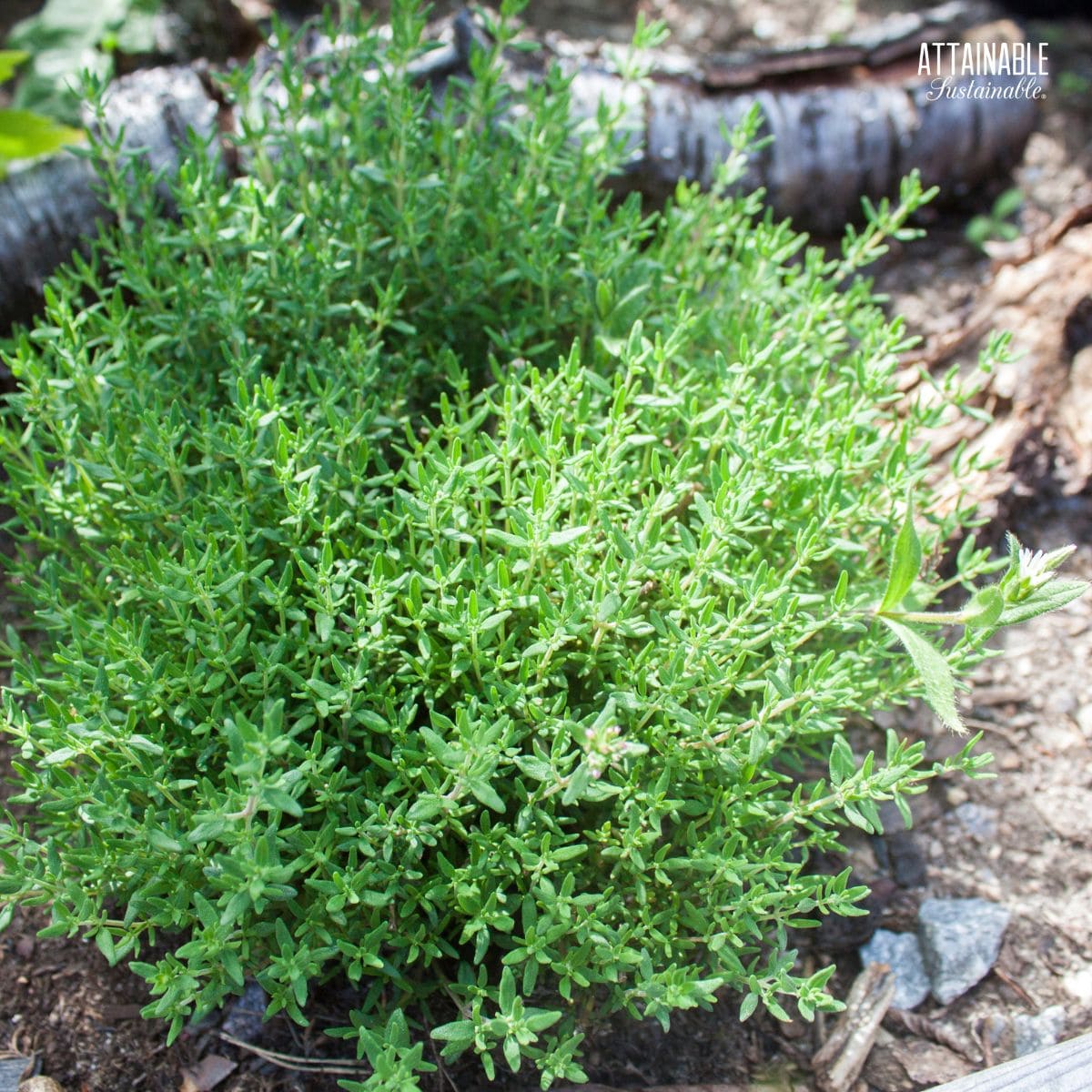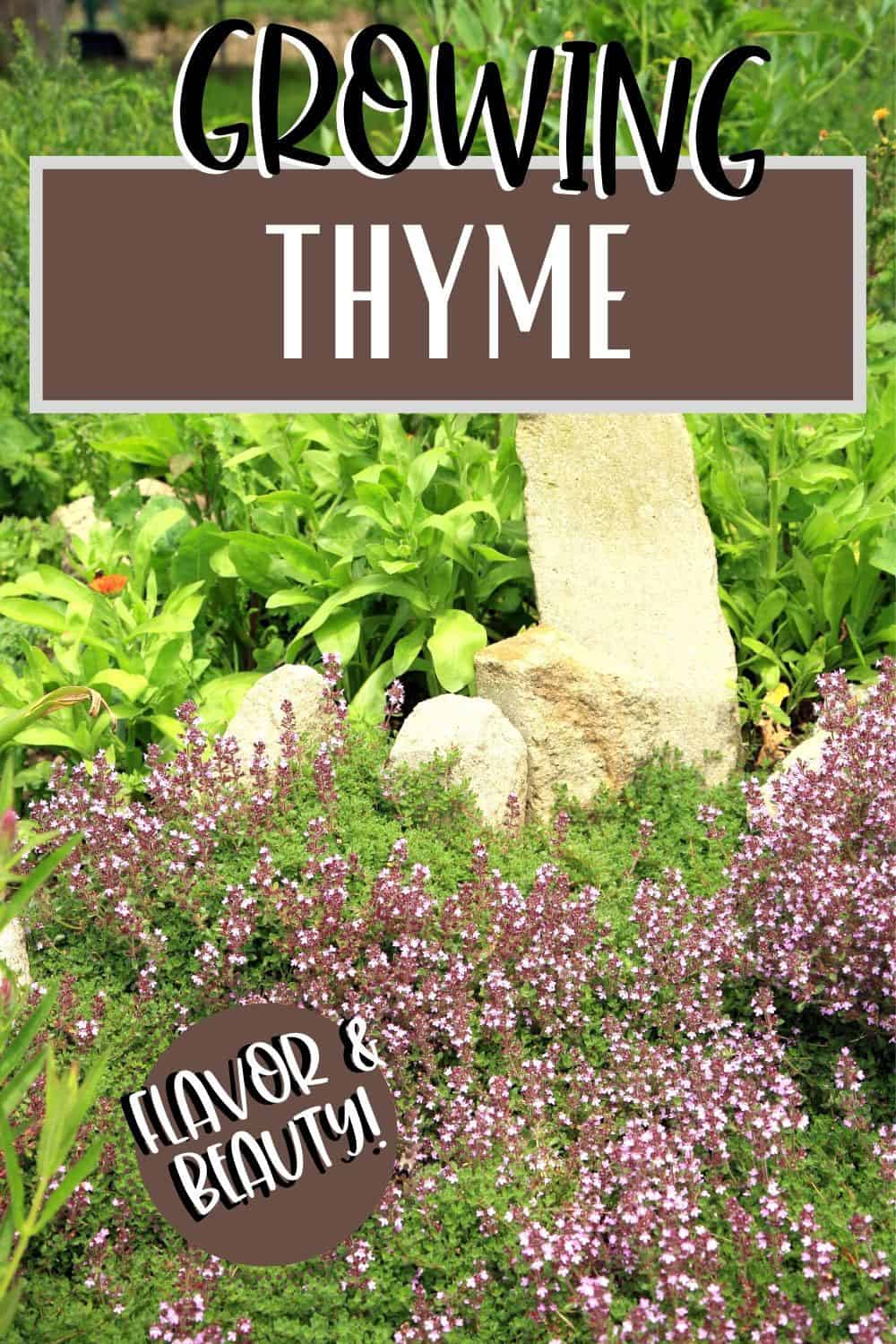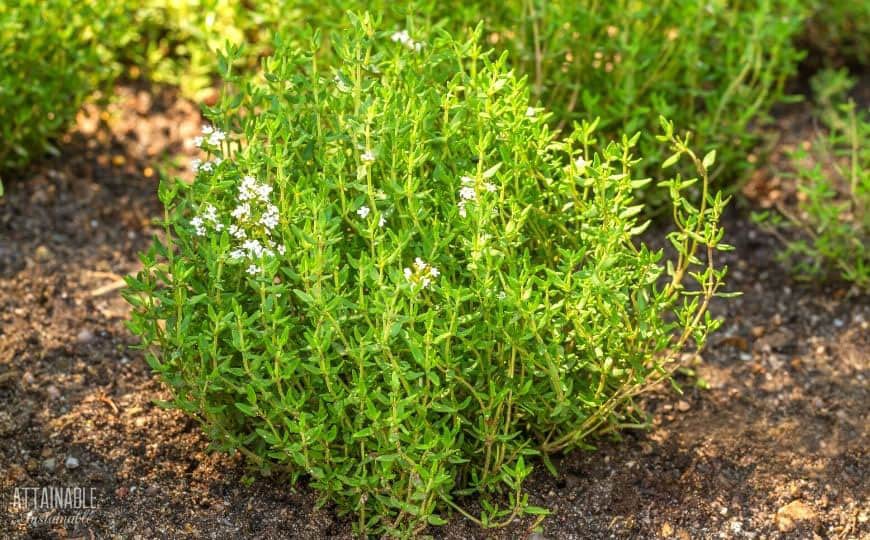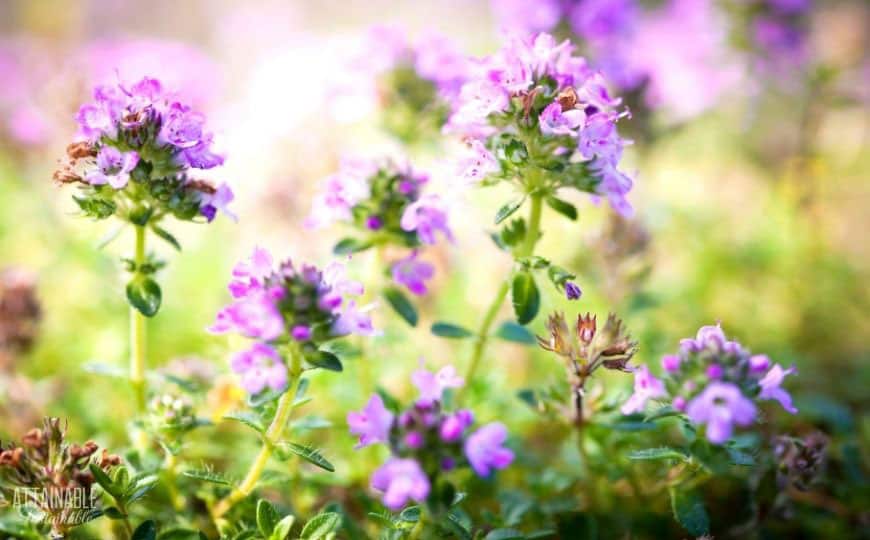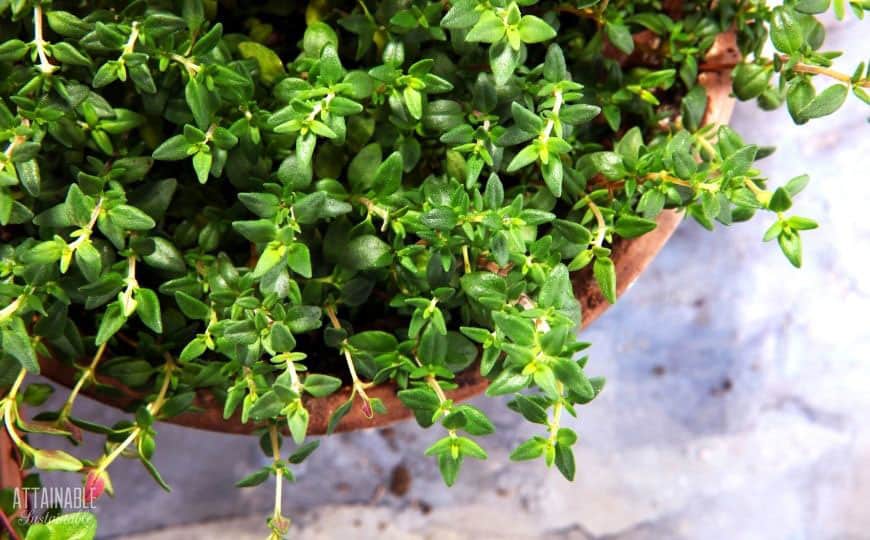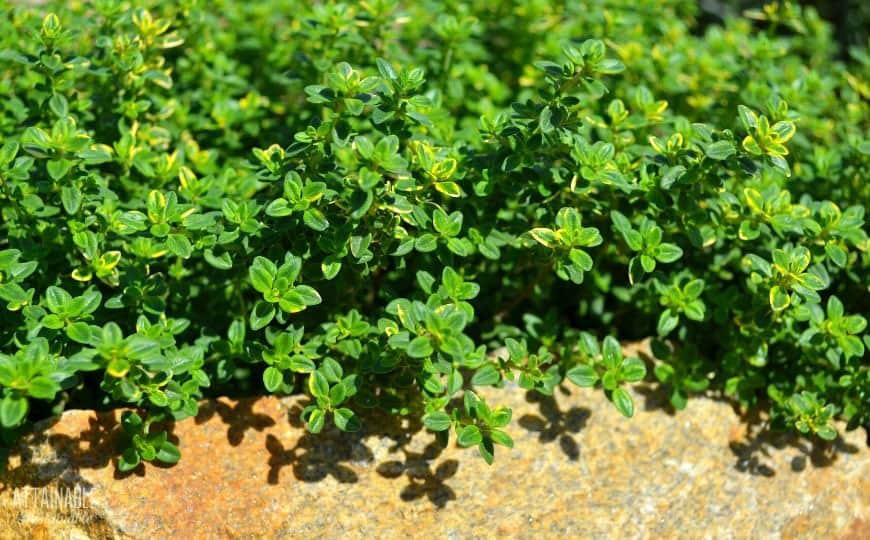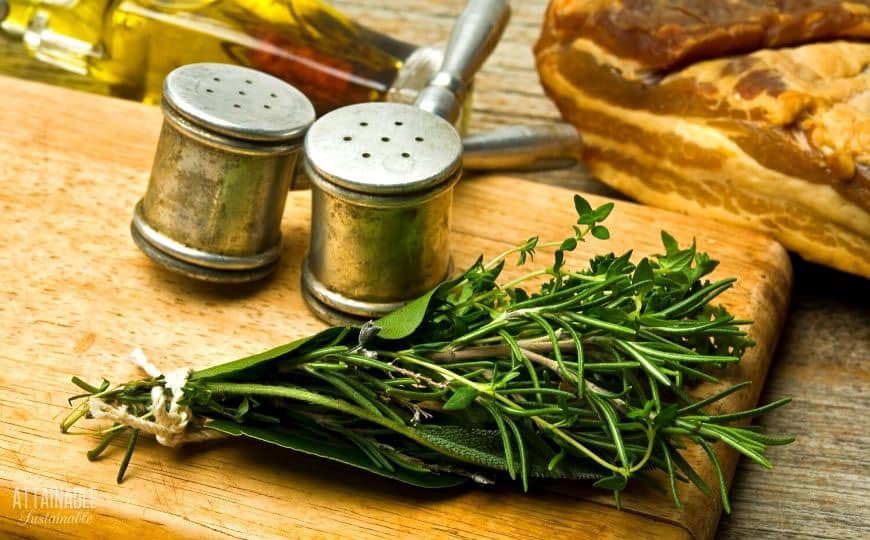Growing thyme in the home garden provides flavor for the table, but it’s also a versatile plant that can fill many needs in the landscape!
Be sure to read this to discover even more herbs to add to your garden.
Contributed by Jodi Torpey, author and Master Gardener.
Thyme is a hardy perennial that can grow as a small upright woody shrub or as a creeping groundcover. This member of the mint family originated in southern Europe and the Mediterranean, but is now a favorite in home herb gardens just about everywhere.
Introduction to Growing Thyme
You’re probably familiar with thyme’s strongly aromatic leaves whether used in cooking or as a groundcover in the garden. With their shrubby nature, gray-green foliage and small white, purple, or pink flowers, thyme plants are an attractive addition to any garden. Bees like the nectar, too, and will visit the plants regularly during the summer months when they are in full bloom.
Thyme (pronounced time) has small leaves that are used either fresh or dried. There are two kinds of thyme: a savory herb for cooking and an evergreen groundcover.
Grow Some Greens!
Ready to grow fresh greens, no matter WHERE you live? Sign up for my
FREE quick-start guide and start growing some of your own food!
Thyme Varieties for Culinary Use
Common thyme (Thymus vulgaris) is often called garden thyme because it’s the most readily available and has a fresh and tangy aroma for many uses in cooking. Two types include French thyme and English thyme. These varieties can grow 8-12 inches tall.
Lemon thyme (Thymus citriodorus) has small, lemon-scented leaves with varieties that can grow as an upright plant or as a ground cover. Golden lemon thyme can also be used like common thyme for cooking.
Thyme as Ground Cover Plant
Wooly thyme (Thyme pseudolanuginosus) is a low-growing and creeping groundcover known for its hairy stems. It’s perfect planted between stepping stones or in rock gardens.
Creeping thyme (Thyme praecox) has smooth instead of hairy stems and makes a nice flowering ground cover.
Wild thyme (Thyme pulegioides) is a fragrant ground cover or rock garden plant with flowers that bees adore.
How to Plant Thyme
Thyme can be planted as a perennial in Hardiness Zones 5-9 or as an annual in other zones. Thyme grows well in the herb garden along with other culinary herbs, vegetable beds, raised beds and as a low-growing shrub in perennial gardens.
Thyme grows well in containers when planted alone or combined with other flavorful herbs that prefer similar light, soil and water conditions such as parsley, sage, and rosemary.
Thyme is a warm-season herb so wait to plant until night-time temperatures are a reliable 50-55 degrees.
The key to growing healthy and productive thyme plants is to make sure they receive plenty of sunshine and are planted in a fertile, well-draining soil to keep roots from rotting.
For the fastest start on the season, start with thyme seedlings from the garden center. Space young plants about 10-12 inches apart. Dig a hole and place transplants at the same depth as they were in the container.
You can also plant thyme seeds; they typically take between 14-21 days to sprout, whether started indoors or direct seeded in the outdoor garden in late spring. Sow seeds about 1/8-inch deep and thin seedlings to about 10 inches apart.
Requirements for Growing Thyme
Light requirements
Because thyme originated in the sunny Mediterranean, plant in a sunny spot with 6 to 8 hours of full sun.
Soil needs
Thyme grows best in a fertile, well-draining soil, like sandy loam. Avoid soil that holds too much water, like clayey soil, because thyme roots have a tendency to rot. Thyme can handle somewhat dry conditions, making it a good choice for gardens facing drought conditions.
Water requirements
Thyme prefers a dry soil, so cut back on watering once plants are established and start growing. Water just enough to keep plants from wilting. One fertilizer application of a balanced fertilizer each season may be enough.
Combating Pests and Other Problems
Thyme is an easy to grow herb, but there are a few pests that can cause problems, such as aphids and spider mites.
Aphids are tiny, pear-shaped insects that suck fluids from plants and spread plant viruses. These insect pests usually show up in clusters and leave behind a sticky substance called honeydew.
Spider mites are tiny pests that feed on many vegetables and herbs, like thyme. Their feeding can cause leaves to turn yellow and drop. Spider mites are hard to see, but you can spot their light webbing on plant stems.
Get rid of both aphids and spider mites in the same way: Use strong blasts of water from a garden hose to wash pests off plants. Spray on top, between and under leaves to get at all surfaces. Respray as needed until pest activity stops.
Another problem that might crop up when growing thyme is a fungal disease called Alternaria blight or Alternaria leaf spot. This fungus shows up during warm and humid weather as yellow, brown or black spots on lower leaves.
To keep the fungus from spreading, remove any leaves and stems that show symptoms. Sometimes it’s best to remove and dispose of the whole plant.
To avoid fungal diseases in the first place, plan for wide spacing between plants to improve air circulation, and water only at the soil surface to keep foliage dry.
Growing Thyme in Containers
Herbs can grow well in containers, either planted on their own or with other herbs. Select a large enough container that matches the size of the mature plants. A big enough container allows plants to grow a healthy root system, plus larger pots won’t need watering quite as often as small containers. Situate the pot in a sunny windowsill in the kitchen and snip off what you need as you cook.
Thyme plants don’t like wet soils so provide good drainage to keep roots from becoming soggy. Make sure there are drainage holes in the bottom of the container to allow excess water drain out. Cover the drainage holes with paper coffee filters to keep soil in place.
Fill containers to two inches below the rim with a quick-draining potting soil meant for container plantings. To give plants a good start, mix in a granular slow-release fertilizer before planting.
If using transplants, dig a small hole in the soil and place plants at the same depth as they were in their container. Gently firm soil around roots and water slowly at soil level to help plants get settled in.
Harvesting
Harvest thyme leaves as you need them in the kitchen, while they’re still young and before the plant flowers. New growth can be encouraged by cutting or pinching back the top 4-6 inches on each stem. Be sure to use the clippings for cooking or drying.
How to Dry Thyme Leaves
Cut thyme from a mature thyme plant early in the morning, rinse leaves, pat dry; gather into small bundles and tie with a rubber band or string to hang to dry.
Another method is to spread stems on a screen to let air circulate around the leaves. When dry, remove leaves from stems and keep in an air-tight container, away from direct sunlight for up to 6 months.
Cooking with Fresh or Dried Thyme
Thyme has many culinary uses; both fresh or dried thyme offers a savory flavor to many kinds of cuisine including Mediterranean, French, Greek, Italian and Cajun. Use thyme for adding flavor to garden-fresh vegetables, meat and fish dishes and for flavoring sauces, soups and stews.
Thyme is often used with parsley and bay leaf in what’s called “bouquet garni,” a small bundle of herbs tied together to flavor stocks, broth, and soups. Tying the herbs in a bundle or placing them together in cheesecloth makes it easy to remove right before serving.
Use some of your fresh thyme in this delicious black cherry preserves recipe.
Propagating Thyme
Home gardeners can propagate thyme by taking thyme cuttings from a healthy parent plant in late summer. Carefully clip 3-inch lengths from the end of branches and remove the lower half of leaves from the stem. Stick the stem in a potting medium to root. Keep the growing medium moist, but not soggy. New thyme plants should be ready to transplant in about eight weeks.

